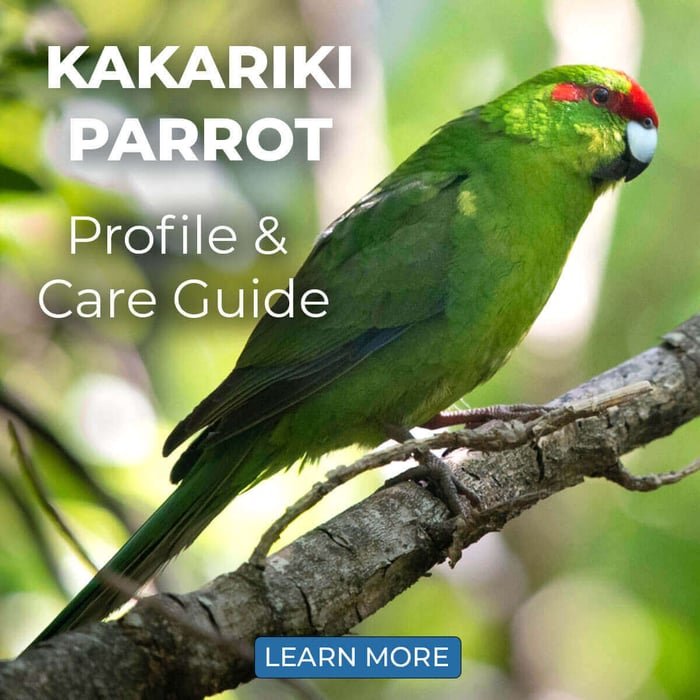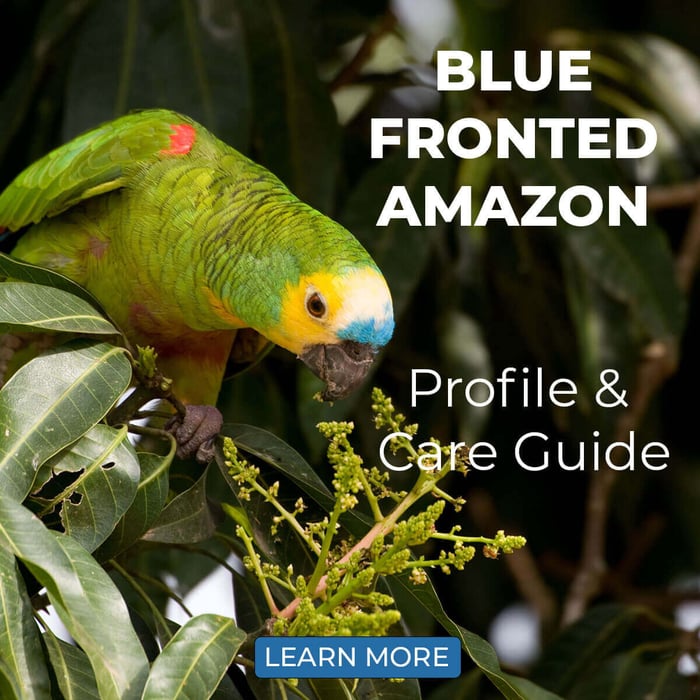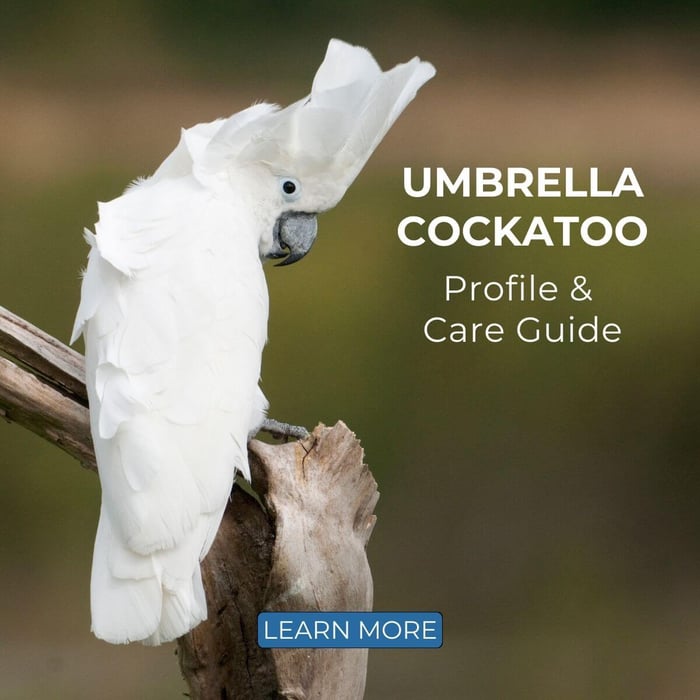Alexandrine Parrot - Profile & Care Guide
| Common name: | Alexandrine parrot, Alexandrine parakeet, epauletted parakeet |
| Scientific name: | Psittacula eupatria |
| Length: | Up to 60 cm with tail |
| Weight: | Up to 300 grams |
| Lifespan: | Up to 30 years |
| Origin: | South and Southeast Asia |
| Noise Level: | Medium |
NATURAL HABITAT
The Alexandrine parrot is native to much of South and Southeast Asia. It can be found as far west as Pakistan and as far east as Cambodia. Here, the species inhabits a wide range of habitats, from rainforests to palm plantations—its only real requirement is the presence of trees with cavities to nest in.
Like its close cousin, the highly invasive Indian ringneck parrot, the Alexandrine parakeet has managed to establish itself in various places outside its natural range. Feral populations, originating from escaped or released pets, can now be found in the Arabian Peninsula, Turkey, Iran, and beyond.
ALEXANDRINE PARROT INTELLIGENCE & PERSONALITY
Parrots in general are known for being highly intelligent, and Alexandrines are no exception. Their advanced problem-solving skills come in handy for finding food in the wild and make these birds highly fascinating, but they also mean that Alexandrine parrots get bored easily. This can lead to issues like excessive vocalization, feather plucking, and even aggression.
As such, (Alexandrine) parrots need a lot of attention in order to meet their intellectual needs. It's crucial for owners to provide an array of toys for medium-sized parrots, which encourage not only physical activity (such as chewing and preening) but also challenge your bird's smart brain. Foraging toys that require manipulation to release treats are particularly effective.
Well-socialized Alexandrines will greatly enjoy spending time with their human family. Although they're not always cuddly, many will appreciate a good neck scratch and like to snuggle up on their owner's shoulder for a nap. They're also highly charming, playful, and trainable. In fact, teaching your Alexandrine parrot various tricks and handy behaviours (step up, wave, etc.) is a highly useful activity for strengthening your mutual bond and preventing boredom in your bird.
In short, parrots like these make wonderful pets for the right owner, but it's important to remember that they are very needy. If you work a regular 9-5 job, you may need to get two Alexandrines so they can keep each other company.
Tip: Parrots love routine. If your bird appears upset, it can help to ask yourself if anything changed. This includes factors like waking and feeding time, the people present in the house, and even whether you decided to wear a hat today!
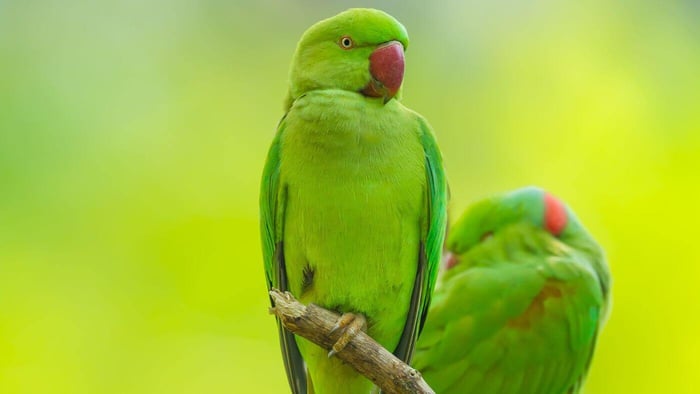
ALEXANDRINE PARROT NOISE LEVEL & TALKING ABILITY
As we've seen above, an Alexandrine parrot's intelligence level is a double-edged sword. Something similar applies to the species' abundant vocalizations: on the one hand, Alexandrine owners greatly enjoy their excellent mimicking skills. Depending on the individual, these birds can learn to imitate an impressive range of words and sounds. All you have to do is repeat the desired phrase or tune throughout the day, particularly during short talking training sessions.
On the flip side, like almost all parrots, Alexandrines can also be quite noisy. We consider their noise level to be moderate for a parrot, but they definitely don't make suitable pets for people who are sensitive to noise (or who live in a flat and whose neighbours are). Their flock calls, which they utilize when they want attention, are quite piercing. They also spend much of the day producing a range of softer squawks and chirps.
Noise is part of being a parrot owner. In fact, a common saying is that "a quiet parrot is a suspicious parrot": if your bird is quiet, it's probably focused on getting up to some mischief, like chewing on something it shouldn't!
FEEDING & NUTRITION FOR YOUR ALEXANDRINE PARROT
Wild Alexandrine parrots eat a varied diet. Their staple foods depend on where they live and the season, but the species is primarily a granivore (seed-eater) and frugivore (fruit-eater). Favourites include wild and cultivated seeds and grains, fruits, nuts, flowers, leaf buds, vegetables and legumes, and even nectar and bugs.
In the home, you should aim to offer your Alexandrine a similar variety of foods. The good old parrot seed mix alone won't cut it, as it's too high in fat and too low in nutrients. Instead, we recommend feeding a high-quality parrot pellet food as a staple.
Supplement with a range of nutritious extras:
- Daily fresh vegetables
- Weekly fresh fruit
- Regular (sprouted) seeds
- Cooked grains
- Foraged foods like fresh parrot-safe branches
- Occasional pieces of boiled egg or mealworms for protein
In addition to their regular meals, parrots also need a calcium block or cuttlebone. Ensure that freshwater is always available, preferably from multiple sources.
HOUSING FOR YOUR ALEXANDRINE PARROT
A parrot's cage is its home, a place where it should feel safe and want to spend time voluntarily. Remember that Alexandrine parrots are not small birds; they need space to move around. A cage length of 40" is the minimum for an Alexandrine that gets to spend most of its day roaming free, but larger is always better. If you don't plan on letting your parrot out, it should live in a full-sized aviary of at least 15 ft.
Your bird's cage should contain a variety of natural wood perches with different textures and diameters, particularly towards the top. As we've already mentioned, a (regularly rotated) variety of parrot-safe toys is also essential. Multiple food and water stations are ideal, especially if you have more than one bird.
Because your Alexandrine parrot should be able to roam free on a daily basis, it can be helpful to set up a dedicated play area with perches, toys, and feeding stations. Most parrot owners place this playground on top of their bird's cage so that it can spend time there when it's not hanging out with its human family.
Tip: Make sure that any space your Alexandrine has access to is 100% free from any hazards such as open windows, toxic plants, or unsupervised electrical cords.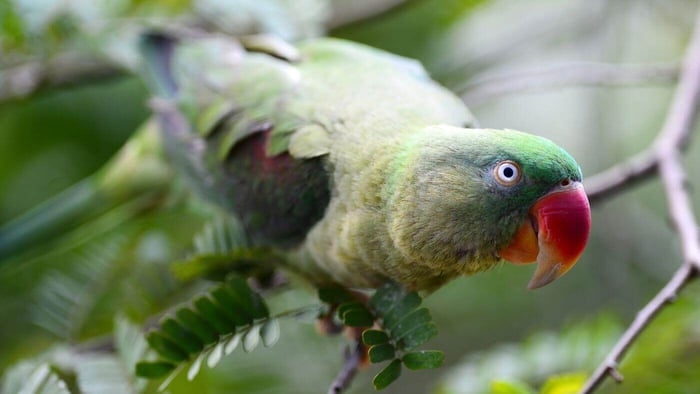
FEATHER PLUCKING IN ALEXANDRINE PARROTS
Feather plucking and other auto-mutilation behaviours are moderately common in these intelligent and sensitive birds. Boredom or physical illness can cause your Alexandrine to begin over preening, which can quickly devolve into actually pulling out the feathers or even chewing at the skin.
If you notice feather plucking, review your bird's living conditions and daily routine. We strongly recommend consulting an avian veterinarian right away to explore both medical and psychological causes, which should hopefully prevent the behaviour from becoming a habit for your Alexandrine parrot.
FACTS
- It can be difficult at first to tell the difference between the Alexandrine parrot and the highly popular Indian ringneck parrot (Alexandrinus krameri). However, Alexandrines are larger and have much heftier heads and beaks. Most notably, they sport a red shoulder patch that their Indian ringneck cousins lack.
- The Alexandrine parrot was considered a member of the genus Psittacula until a revision in 2019, when it was moved to the genus Palaeornis. This genus only contains one other species, but it's unfortunately extinct: the Seychelles parakeet, P. wardi.
- There are five recognized subspecies of Alexandrine parrot, although the differences between them are small. They are called Paleornis eupatria eupatria, P. e. nipalensis (the largest, with blueish cheeks), P. e. avensis (smaller beak, with a blue streak on the back of the neck), P. e. magnirostris (relatively large, with brighter shoulder patch), and P. e. siamensis (the smallest).
- The IUCN Red List considers Palaeornis eupatria to be a Near Threatened species. The organization notes that although this parrot can locally be quite common, it's unfortunately suspected that the population is on the decline due to habitat loss and trapping/killing by humans.
- The Alexandrine parrot is a common crop pest in its natural range. It will feed on agricultural products like maize, grain, and fruits, which leads to persecution by farmers.
- Alexandrine parrots have a long history as pets. Alexander the Great has been said to have transported a large amount of these birds from India to Europe to give to local royalty, and apparently also owned some himself—hence the species' common name.
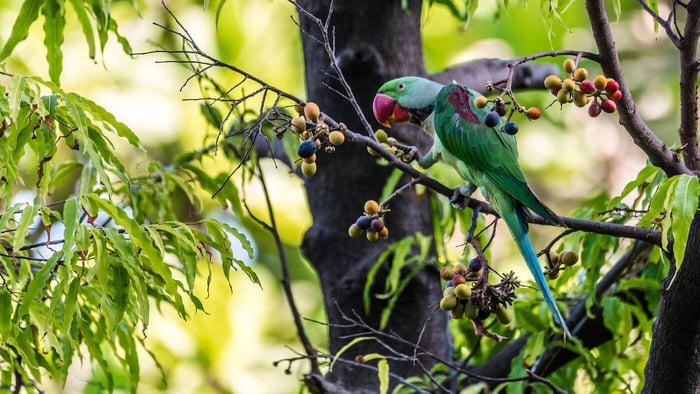
CONCLUSION
An Alexandrine parrot can make a great pet for the right owner, but these parrots do require specialized care and abundant attention. They thrive on mental stimulation and social interaction, plus a healthy and varied diet, so consider whether you can offer this in the long run before adding one to your family.
To view other Parrot Profiles & Care Guides, visit our Alphabetical list of Parrot Fact Sheets by visiting: https://parrotessentials.co.uk/blog/parrot-profiles-care-guides
Parr, M., & Juniper, T. (2010). Parrots: a guide to parrots of the world. Bloomsbury Publishing.

